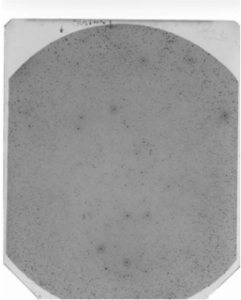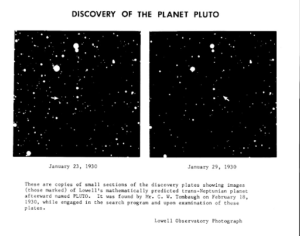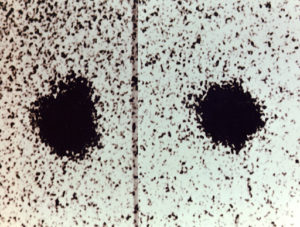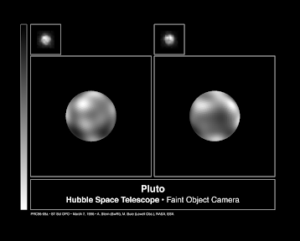
NASA/Johns Hopkins University Applied Physics Laboratory/Southwest Research Institute
By Claire Gibson, Lowell Educator
92 years of imaging Pluto have allowed a closer and more detailed look at the cold, small body located over 3.2 billion miles away from Earth. Through time, with new telescopes and space probes, tantalizing glimpses of the intricate surface of the small dwarf planet have been revealed. Let us explore the images of Pluto throughout the years that have sparked discovery and changed the history of astronomy forever.
Surprisingly, the first image of Pluto was taken before it was officially discovered by Clyde Tombaugh at Lowell Observatory in 1930. The first image was taken by astronomer Thomas Gill at Lowell Observatory in 1915, between April and May, using a nine-inch telescope borrowed from Swarthmore College. Percival undertook a passionate search for what he called “Planet X.” He took photographs of the sky where Planet X was predicted to be lurking, but failed to recognize Pluto because it was much fainter than expected. Percival died suddenly in 1916, not knowing he had in fact taken an image of Pluto. Only with the lens of history can we look back and recognize those photographs as containing some of the first images of Pluto.

Lowell Observatory Archives

Credit: Lowell Observatory, “Pluto Discovery Plates”
Percival paved the way for the next era of exploration of Planet X at Lowell Observatory. In February of 1930, after about nine months of taking images of the sky and analyzing them for the movement of a planet did Clyde Tombaugh happen upon Pluto.
Many years later, with the advent of new telescopic imaging technology, astronomers began to see that Pluto was not alone in the outer solar system. In July of 1978, the discovery of Pluto’s largest moon, Charon, was announced. The discovery was made by James W. Christy, using the 1.55-m (61-inch) Kaj Strand Astrometric Reflector at the United States Naval Observatory Flagstaff Station in Arizona. In this image, Pluto is seen as a fuzzy lump in the middle, with the elongated part of the image being Charon. The elongated lump was studied by Christy and later found to be a large moon of Pluto.

Credit: U.S. Naval Observatory
The launch of the Hubble Space telescope allowed astronomers an even more detailed look at Pluto’s system. The first image of Pluto taken by the HST was in 1994, and the image shows both Pluto and Charon. At the time, this was the clearest photograph of Pluto ever taken. That would soon change.
In 1996, just a few years later, the Hubble Space Telescope returned its gaze to Pluto to take a detailed image of the surfac
e. This image was taken 66 years after the discovery of Pluto, and showed views of large-scale contrast on the surface, more than any other planet in the solar system besides Earth. The image paved the way for the development of the New Horizons spacecraft that would eventually reach Pluto by 2015.

Alan Stern (Southwest Research Institute), Marc Buie (Lowell Observatory), NASA and ESA
In 2005-2006, two additional moons of Pluto were discovered using the Hubble Space Telescope. The moons were named Nix and Hydra by the International Astronomical Union. Years later, another moon, named Kerberos, was found while looking for a possible ring system around Pluto in 2011. Lastly, one other moon, called Styx, was discovered in 2012 while the New Horizons team were surveying the space around Pluto to look for potential hazards to the spacecraft.
What have earth-based telescopes been doing in terms of imaging Pluto? One of the best Earth-based photographs of Pluto was taken at the Gemini Observatory in Hawai’i. The image shows both Pluto and its large companion moon Charon. A special technique called reconstructive speckle imaging was used in this photograph taken in September of 2012.
On July 14, 2015, history was made as the New Horizons spacecraft made its closest approach to Pluto, and sent breathtaking images back to Earth. The first detailed image of Pluto and its coloration were taken with the Multispectral Visible Imaging Camera. Views of Pluto’s “heart”, craters, ridges and mountains were revealed with incredible detail.
That’s not all, however! Zooming in, there are many photographs of specific areas on the surface of Pluto. Many images have been returned from the spacecraft that show the majestic features of Pluto, such as the edge of Sputnik Planum and the rocky Al-Idrisi Montes region.
One last spectacular and never before seen look at Pluto happened after the flyby from New Horizons, where the spacecraft turned around and glimpsed the hazy atmosphere illuminated by the Sun behind. The image was taken about 3.5 hours after the closest approach to Pluto. The departure photograph marked a hallmark of achievement in planetary exploration and revealed the wonder of imaging bodies in our solar system at some of its farthest reaches.
The evolving image of Pluto is testament to persistence of astronomers and the public wanting to look up at the night sky and discover all that we can, even if it takes 92 years after the discovery of Pluto to see some of the majesty our Solar System holds.